foot health care
6 Best Bunion Treatments at Home For Fast Pain Relief
Bunions are a common problem in the United States. It affects 1 out of 3 Americans, especially those in the older age group. Although they barely require medical treatment, they can become painful and cause discomfort and inconvenience to affected individuals.
There are many natural remedies for bunion pain, and the best one for you will depend on the individual symptoms and cause of the pain. In this article, we will cover some of the best bunion treatments at home with natural remedies (non-surgical options) as well as surgical options for bunion pain relief.
What Is a Bunion?
A bunion, also known as Hallux Valgus, is a painful bony bump that develops and grows in the metatarsophalangeal joint or the joint that connects your foot and your big toe. This growing bony bump results in your big toe pulling towards the smaller toes and the joint sticking outwards.
What does the term bunion mean?
The word ‘Bunion’ originated from the Old French word Buignon, which means “bump in the head”. In modern times, the word bunion mostly refers to the painful swelling of the big toe.
Arthritis and Bunions: Understanding the Link
It is a common misconception that Big Toe Arthritis (Hallux Limitus, Hallux Rigidus) and Bunions (Hallux Valgus) are the same conditions. This isn’t really surprising due to the fact that both conditions cause pain and bump on the big toe joint. These two conditions are entirely different from each other.
However, people with certain types of arthritis such as rheumatoid arthritis are also at risk of developing a bunion.
Rheumatoid Arthritis
Rheumatoid arthritis is an autoimmune and inflammatory disease where the immune system attacks healthy cells and causes inflammation. People with this disease are more at risk of developing bunions caused by the inflammation that takes place on the joint.
What causes bunions, and can you prevent them?
A bunion (Hallux Valgus), on the other hand, is developed when the base of the first segment of the big toe and the first metatarsal bone’s far end misaligns. As a result, the big toe moves sideways towards the direction of the little toe while the tip of the metatarsal bone moves in the opposite direction, towards the opposite foot.
Can bunions be corrected without surgery?
Yes, bunions can be corrected without surgery in some cases. If the bunion is not too severe, it can be treated with conservative measures such as wearing shoes that fit properly and do not rub against the bunion, using bunion pads or braces to protect the bunion, and taking anti-inflammatory medications. In more severe cases, surgery may be necessary to correct the bunion.
Non-surgical bunion treatments are always the first step when it comes to correcting bunions. Surgery will only become an option if the bunion causes severe foot pain and inflammation that cannot be relieved by non-surgical treatment. Another reason to consider surgery is if the bunion has caused deformity it makes straightening or bending of the big toe impossible.
Downsides of Bunion Surgery
Like any other kind of surgical procedure, bunion surgery might result in complications and risks. Among the possible complications are infection, delayed healing, numbness, and swelling. In some cases, surgery might also result in nerve damage, severe pain, and overcorrection of the problem in which the big toe would extend way too much towards the opposite direction.
Do bunion splints work to remove or heal bunions?
Although no specific study has proven the effectiveness of using bunion splints to heal or remove bunions, studies show that they can significantly reduce the pain of the bunion while walking, running, or resting. It might also slow down or prevent the progression of the bunion.
The Benefits of Using a Bunion Brace

Bunion braces or splints can help relieve pain and reduce the pressure on the affected area. It works by repositioning the big toe to its anatomically correct position. This helps the patient gain balance and a steady gait. It also helps relieve and prevent pains of the neighboring toes.
Possible Post-Operative Benefits of Bunion Splints
Bunion splints can provide the support that the post-operative foot needs. It helps maintain the correct position of the big toe while the bone, tendons, and ligaments are healing. It could also help in breaking scar tissues apart and assist with the patient’s movements.
Best Bunion Treatments: Understanding Your Options
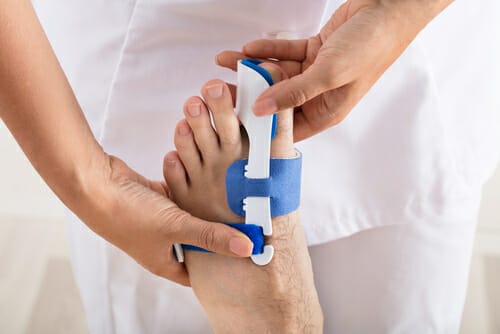
As mentioned earlier, surgery is not the first and only treatment option available for relieving bunion pains. Through proper investigation of your condition and consultation with a podiatrist (foot specialist), you can get bunion relief without the need for surgery.
Non-Surgical Bunion Treatments – Natural Home Remedies to relieve bunion pain
You can alleviate the pain and discomfort caused by bunions by doing some of these simple yet effective natural home remedies:
1) Bunion Braces and Splints
What are Bunion Braces and how do they work?
Bunion braces are among the most widely used natural treatment for bunions. By wrapping around your foot, the device promotes proper alignment of your toes. It is used as an overnight treatment and removed upon waking up in the morning as it cannot be worn with shoes.
How do bunion correctors work?
With various designs available in the market, bunion correctors prevent the big toe from getting in contact with the other toes by keeping them separated. This results in the reduction of pain, pressure, and swelling of the joints.
Types of Bunion Correctors and Separators
- Gel Bunion Correctors, Separators, and Protectors
These are made of a gel-filled material with a non-slip grip insert that provides fast and cost-effective pain relief for bunions. Most gel correctors are flexible and can fit different sizes of feet. They work by preventing the big toe from getting in contact with other toes. They also protect bunions against shoe pressure and friction.
Recommendations: PediFix Visco-GEL Bunion Guard, Pedifix Nighttime Bunion Regulator Splint, and Pedifix Visco-GEL Dual-Action Bunion Fix
Pedifix Dual-Action Bunion Fix
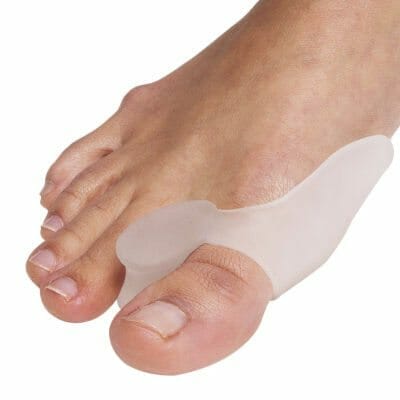
- Helps with bunion relief and toe discomfort
- Great for recovering from bunion surgery
- Safe to wear while walking, hiking, or sleeping
- Gel ring protects bunion and absorbs friction
- Helps with separation and re-alignment of the big toe
- Increase Blood circulation
- Fits comfortably under socks and inside shoes
- Easy to use and clean
- Completely washable and reusable
- Made of durable medical-grade gel
Pedifix Visco-GEL Bunion Guard
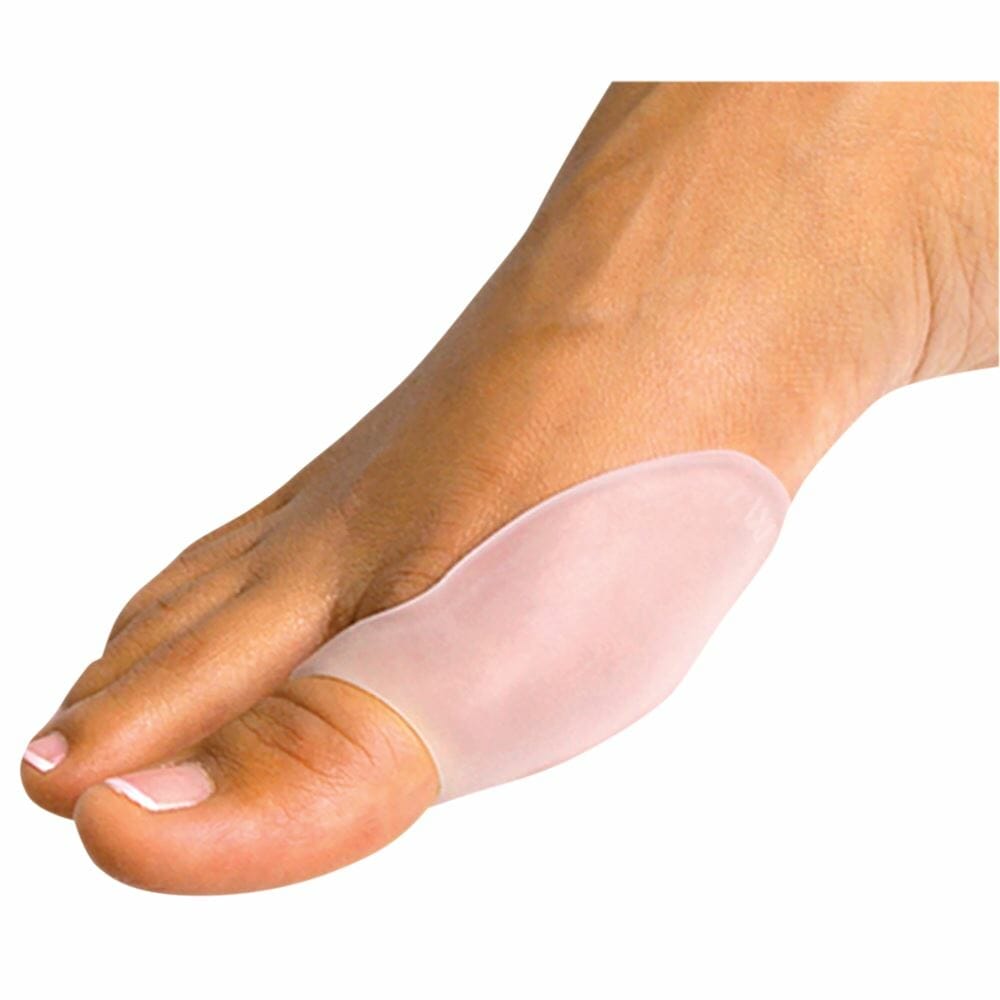
- Protects the hallux and/or tailor’s bunion
- Soft and flexible medical-grade gel
- Provides cushioning and comfort to the skin
- Stretchable toe loop that keeps the bunion guard in place without adhesives.
- Easy to wash, reusable, and effective for months.
- Slim design fits in most footwear
- Provides comfort in shoes
- Interchangeable for left or right foot
Pedifix Nighttime Bunion Splint

- Helps soothe and relieve bunion Pain
- Corrects the alignment of the big toe
- Doctor-developed for bunion relief during nighttime
- Recommended by podiatrists as an alternative to Bunion surgery (can also be used as a post-surgical splint).
- Reduces the progression of the bunion deformity
- Perfect to wear while resting or sleeping
- If desired, a sock can be worn over the splint to reduce friction while sleeping
- Available for left and right feet in different sizes
- Fabric Bunion Protectors
Except for being made from a different material, fabric bunion protectors feature the same protective properties as gel bunion protectors. Fabric bunion protectors are made of elastic fabrics that are strategically designed to relieve painful and sensitive bunions.
Recommendations: PediFix Pedi-GEL Bunion Shield, Pedifix Visco-gel Bunion Relief Fabric Sleeve
PediFix Pedi-GEL Bunion Shield
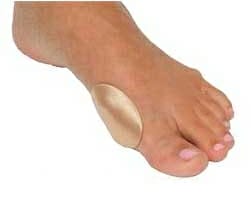
- Provides instant relief from painful bunions
- Absorbs friction and pressure
- Self-adhesive and sticks firmly even after repeated uses
- Relieves bunion while providing a cushion & protection
- Thin design, fits in all shoes and stays in place
- Durable Washable & Reusable
- Fits in most shoes of all sizes
- One size fits most
Pedifix Visco-gel Bunion Fabric Sleeve
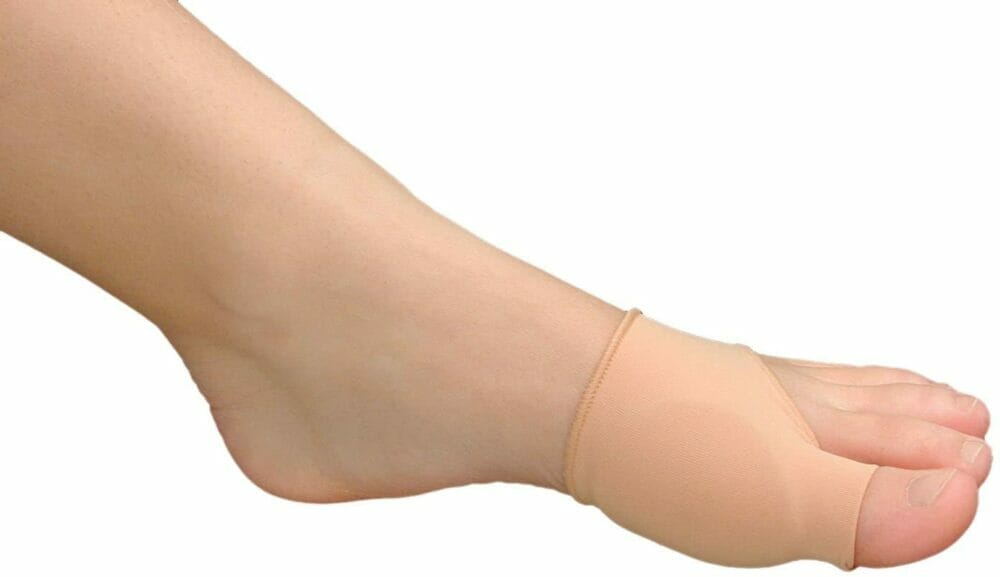
- Relieves Bunion (Hallux Valgus) Pain
- Protect against shoe pressure and friction
- Fits comfortably in your shoes
- Promotes better blood circulation
- Interchangeable for both left and right feet
- Made of soft stretch fabric and a comfortable gel pad
- Washable and reusable
- Bunion Splints
Intended for night use, a bunion splint is a device that is wrapped around your foot to separate or push away the big toe from the adjacent toes. It provides immobilization and support to the affected area, relieves pain and pressure, and delays the development of a bunion.
Recommendations: DARCO Toe Alignment Splint, PediFix Nighttime Bunion Regulator Splint, Pedifix Adjustable Bunion (Hallux Valgus) DaySplint
DARCO Toe Alignment Splint

- Soft elasticized cotton fabric
- Cushioned foam interior
- Special t-strap that maintains toes alignment
- 4 (four) individual soft toe loops
- Post-surgery toe alignment
- One-size-fits-all design
- Fits right or left foot
PediFix Nighttime Bunion Splint

- Helps soothe and relieve bunion Pain
- Corrects the alignment of the big toe
- Doctor-developed for bunion relief during nighttime
- Recommended by podiatrists as an alternative to Bunion surgery (can also be used as a post-surgical splint).
- Reduces the progression of the bunion deformity
- Perfect to wear while resting or sleeping
- If desired, a sock can be worn over the splint to reduce friction while sleeping
- Available for left and right feet in different sizes
Pedifix Adjustable Bunion DaySplint
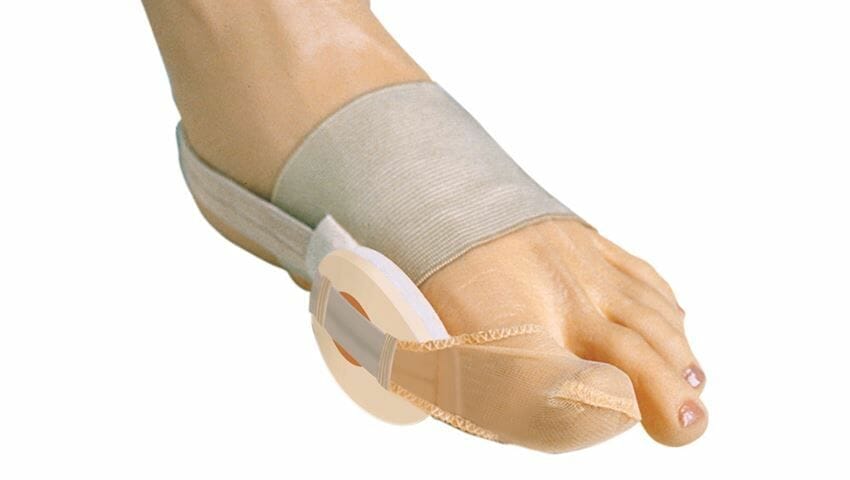
- Aligns Big Toe to Reduce Pain
- Reduces pressure on the Big Toe Joint
- Adjustable alignment control
- Permits Hallux (bunion) flexion and extension
- Speeds up the healing process
- Can be used either with the surgical dressing or after it is removed.
- Can be easily removed, adjusted, and re-applied.
- Fits comfortably in most shoes
- Washable and reusable
- Bunion Pads
A bunion pad’s primary use is to help relieve the pain and discomfort caused by a bunion. It prevents the bunion from rubbing against the inside of the shoe by creating a cushioned barrier between the two. A bunion pad also prevents knocks and bumps from causing pain, discomfort, and further irritation to the bunion.
Recommendation: PediFix Visco-GEL Moleskin Protective Padding and Pedifix Visco-GEL Dual-Action Bunion Fix
PediFix Visco-GEL Moleskin Padding

- Patented Visco-GEL that moisturizes skin
- Self-adhesive sheets that stay on the skin
- Absorbs pressure and friction on foot’s soft spots
- Soft and durable moleskin fabric
- Conform to any foot contours
- Heals and prevents callus, corns, and blisters
- Washable and reusable
- 2 (two) 2.5 x 3 inches sheets trimmable to fit
Pedifix Dual-Action Bunion Fix

- Helps with bunion relief and toe discomfort
- Great for recovering from bunion surgery
- Safe to wear while walking, hiking, or sleeping
- Gel ring protects bunion and absorbs friction
- Helps with separation and re-alignment of the big toe
- Increase Blood circulation
- Fits comfortably under socks and inside shoes
- Easy to use and clean
- Completely washable and reusable
- Made of durable medical-grade gel
- Bunion Exercise Bands
These elastic bands are a great aid when performing exercises to correct and prevent bunions. It works by strengthening the abductor hallucis, the muscle located on the inner side of the foot, to help maintain the movements and natural positioning of the big toe.
Which Bunion Corrector Works the Best?
Regardless of the bunion corrector you choose, its effectiveness relies greatly on the severity of your bunion. Also, it is important to keep in mind that their main purpose is to reduce the symptoms and not to actually correct or remove the bunion. Proper bunion care is also crucial.
Browse our catalog for the best-selling bunion braces and splints.
2) Medications for bunion pain
While no medications can remove or shrink bunions, certain over-the-counter medicines can help control or relieve bunion pains. NSAIDs such as Ibuprofen, Acetaminophen, or naproxen sodium are the most common drugs used. Cortisone injections can also help.
3) Exercise and Stretching
Doing some foot stretches and exercises can help alleviate the pain caused by bunions. A variety of exercises can be added to your daily exercise routine to help you strengthen your feet and toe muscles, and manage your symptoms.
Bunion Reversal Exercises
Bunion Stretch and Soft Tissue Release
4) Wear the right shoes
Wearing well-fitted footwear is one of the best things to do to prevent bunions from getting worse. Since it is not possible to not wear shoes at all times, wearing shoes that is a little loose on your foot, and have a wide toe box and excellent arch support can help you. Avoid wearing high heels every day as they can push and put more pressure on your toes.
5) Use the right mix of hot and cold therapy
Alternating hot and cold therapy is a huge help in managing your bunion. Cold therapy reduces inflammation while heat therapy helps with blood circulation and relaxes painful joint muscles.
6) Maintain a healthy weight
Being overweight can cause more pressure on your foot and big toe and the higher the pressure means the higher chance of developing or worsening the bunion.
Frequently Asked Questions About Home Bunion Remedies:
Can I shrink my bunions naturally?
Bunions can’t be shrunk or removed naturally, but there are non-surgical treatments that can help minimize symptoms and prevent bunions from worsening.
Do Bunion Braces/Splints Actually Work?
With proper use, bunion braces/splints promote the correct anatomical position of the big toe which can help relieve pains associated with the condition.
Are Bunion Braces Safe?
Bunion braces are generally safe to wear as long as proper wear instructions are followed. There are a few potential risks associated with bunion braces, such as skin irritation or discomfort, but these are typically minor and easily resolved. Overall, bunion braces are safe for most people and can be an effective way to treat the condition.
How Long Should I Wear Bunion Braces/Splints?
Depending on your condition, bunion braces/splints may be worn for weeks. Your healthcare provider should determine how long you have to wear them according to your situation.
What are the Temporary Effects of Using Bunion Splints?
While in use, a bunion splint spaces your toes out thus relieving the pain of rubbing toes. It can also help with post-operative treatment. It maintains the correct position of the toes while ligaments and bones are healing. It also helps with the toe’s range of motion.
Are Bunion Splints Supposed To Hurt?
As long as properly applied, bunion splints don’t hurt. However, they may cause mild discomfort and mild inconvenience. They are intended for night use while sleeping. You can’t wear them with shoes.
Why do women get bunions more often than men?
Among the possible reasons women get bunions more often than men is that they have weaker tissues in the feet. Another reason is that women are more likely to wear high-heeled and tight shoes.
Are Bunion Splints Supposed To Hurt?
As long as properly applied, bunion splints don’t hurt. However, they may cause mild discomfort and mild inconvenience. They are intended for night use while sleeping. You can’t wear them with shoes.
Why do women get bunions more often than men?
Among the possible reasons women get bunions more often than men is that they have weaker tissues in the feet. Another reason is that women are more likely to wear high-heeled and tight shoes.
Surgical Bunion Treatments – Talk with your podiatrist about surgical options
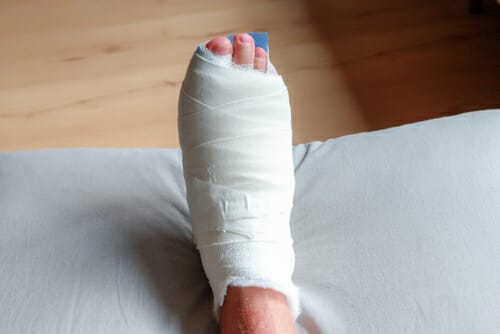
Surgery only becomes an option if other non-surgical options don’t work, you can’t bend or straighten your toes, or in the presence of visible and painful deformity. Depending on the severity of the patient’s condition, there are various types of surgery producers to perform. You should talk to your podiatrists about these options – their benefits and possible risks.
How to know if you need bunion surgery?
Severe foot pains are among the primary indications that you might need surgery. These pains don’t go even when wearing comfortable shoes. Another indication is the chronic inflammation and swelling of the affected toe that can’t be relieved even when resting or taking medications.
Surgical Options for Bunion Pain
These are three bunion surgery techniques that are commonly used for bunion surgeries:
- Exostectomy – This procedure is only done with minor bunions. It involves shaving off the bunion and is often combined with an osteotomy to reposition toes.
- Osteotomy – is one of the most common techniques used in bunion surgeries, osteotomy is performed by making small incisions in the bones and using screws or pins to realign the big toe joint.
- Arthrodesis – when arthritis gets inflamed, it could lead to the development of bunions. With an arthrodesis procedure, your surgeon will remove the parts of the big toe joint that have arthritis and place screws on the toe to hold bones together while healing. This technique is often used for the most severe bunions.
What to expect after bunion surgery?
After your bunion surgery, it is expected that you will wear a cast for months. Your pain and swelling will improve six weeks after the surgery, but minor pain and swelling will probably last until six months or a year.
New Bunion Surgery Treatment – Lapiplasty®
The Lapiplasty 3D Correction is a new and advanced bunion surgery technique that has been developed recently. Although there is no long-term data available yet, recent surgery results have shown that almost 100% of patients maintained the correction after a year.
- How does Lapiplasty® Work?
Lapiplasty surgery works by correcting not only the bunion but also its source. The procedure corrects your metatarsal bone’s sideways lean, stops the abnormal rotation of the bone which often leads to inflammation, and prevents the bone from arching upward and putting pressure on the other toes.
- Can I Have Lapiplasty Performed On Both Feet At The Same Time?
It’s possible to have Lapiplasty surgery on both feet at the same time as long as you have someone to support and take care of you at home after the surgery. You will have to discuss this with your surgeon for him to check if you could be a candidate to have the surgery on both feet.
- What to Expect In Terms Of Recovery?
Depending on your body’s ability to heal, recovery after a Lapiplasty surgery may take up to a few weeks. You may be able to walk within a few days and return to work wearing your surgical boot. Most patients are also expected to go back to walking in normal shoes around six weeks after the surgery.
Conclusion
A bunion that doesn’t show any symptoms is generally safe and should not be a cause of concern. But if your bunions become painful and bothersome, there are a variety of non-surgical treatments, exercises, and medicines that can help. For bunions that cause severe pains and chronic inflammation that does not react to non-surgical treatments, you should consult with a podiatrist for surgery options.


